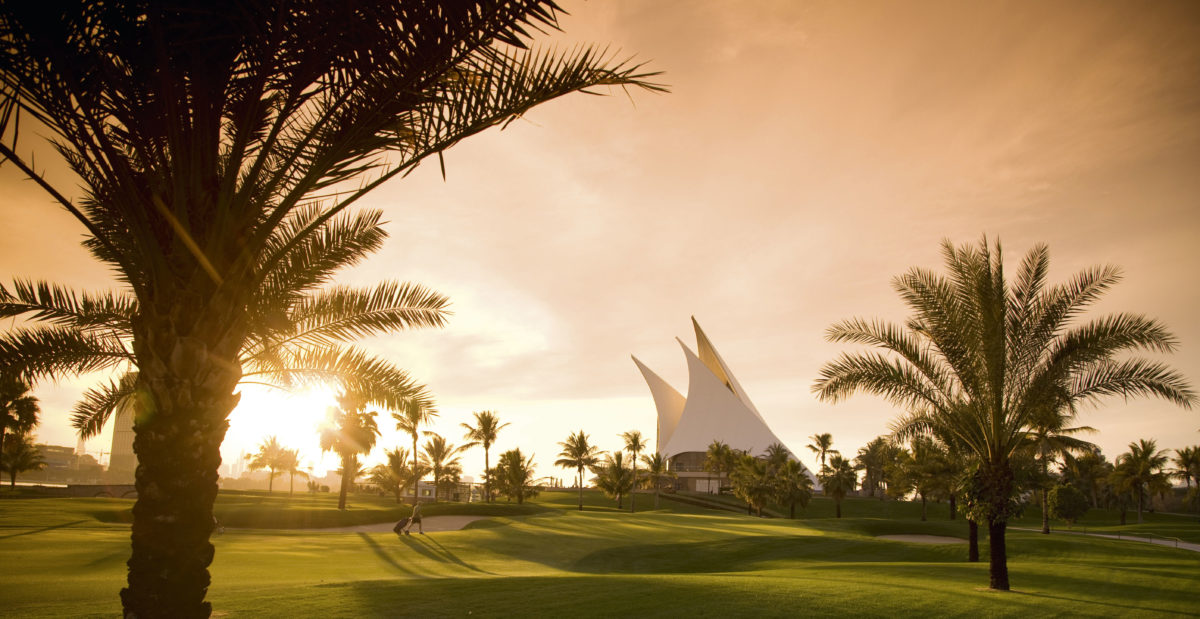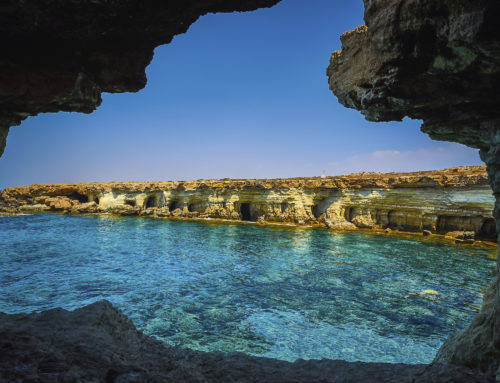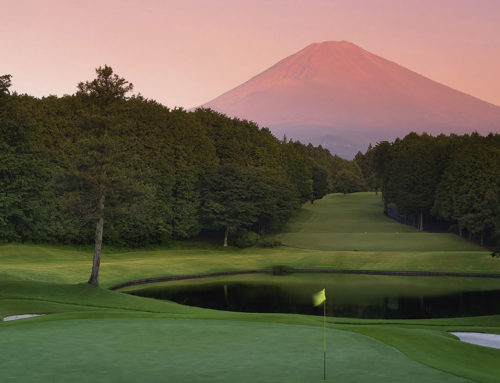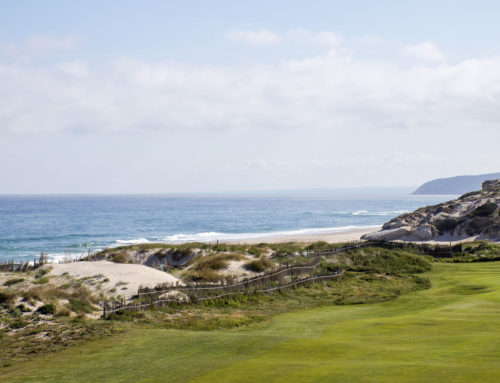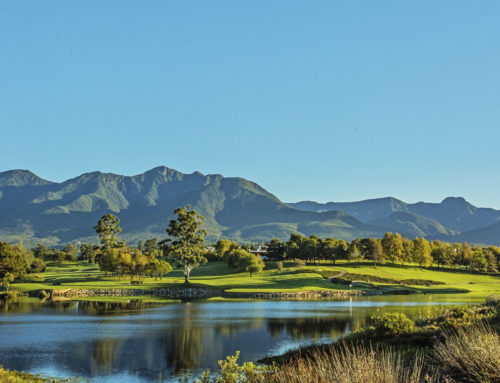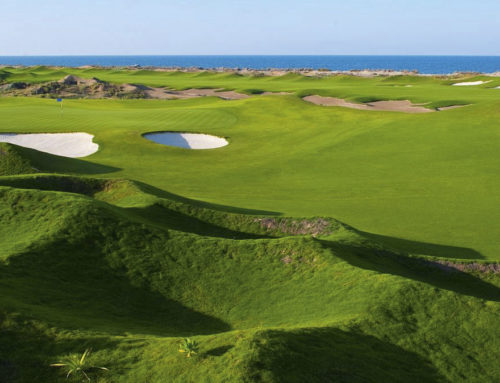There’s no getting away from Donald Trump these days — even in the sun-baked outskirts of Dubai. Here, in the far south-west of the city, where the scrub and dunes of the UAE interior rub up against exclusive residences with manicured lawns, lies The Trump Estates at DAMAC Hills.
The exclusive gated enclave bearing the imprimatur of the property magnate — and current US President — offers a selection of grandiose mansions as well as an outdoor cinema and all the amenities an upper-crust expatriate might require such as extensive shopping and dining options and international schools.
Most notable for golfers, though, is the presence at the development of the Trump International Golf Club. Designed by superstar architect Gil Hanse, the layout is earning rave reviews for its links-style design and world-class conditioning. More significant perhaps is the fact that the course — which opened for play in 2017 — is symbolic of an upturn in Dubai’s status as a thriving golf destination after a period of relative quiet.
Ten years ago, at the height of Dubai’s hyper-charged rush to become a global tourism leader, its momentum fuelled by a combination of oil money and the towering ambition of its rulers, the Al Maktoum family, the sky appeared to be the limit for the destination’s golfing potential.
From the early 1990s, the emirate witnessed a boom in golf course construction that echoed its own transformation from a neglected desert backwater into one of the most dynamic and strategically important places on earth.
Following hot in the footsteps of the Majlis course at the Emirates Golf Club — the first grass course in the UAE, opened in 1987 — came other stellar layouts such as Dubai Creek, Arabian Ranches and The Montgomerie.
With ambitious real estate projects fuelling the building frenzy, the construction of top-class golf courses continued unabated. The Els Club, designed by South African Ernie Els, opened for play in 2008 and was swiftly followed in 2009 by the two Greg Norman-designed tracks (Fire and Earth) at Jumeirah Golf Estates.
It was all a far cry from days of old when the only golf courses in the UAE were grass-free affairs where golfers used AstroTurf mats to hit shots onto ‘browns’ made from heavily oiled sands.
However, the opening of the courses at Jumeirah Golf Estates turned out to be something of a turning point for golf in Dubai. The global financial crisis of 2008 hit the emirate viciously, as local and international construction firms were left heavily exposed.
A multi-billion dollar bailout from neighbouring emirate Abu Dhabi prevented total disaster, but the crisis certainly did propagate a more sober approach to development — with the rush of new golfing projects slowing to a trickle.
The boom era in Dubai did bequeath some outstanding golfing quarry. And with new courses such as the Trump International Golf Club offering fresh variety, the emirate is reasserting its authority as the number one golf destination in the Middle East.
The lifestyle perks don’t hurt either, of course.
To those who like a hefty sprinkling of glam with their sun, sea and sand, Dubai’s reputation as a place where the ‘good life’ can be taken to its most fantastical heights is a large part of its appeal.
By day the endless beaches, the azure waters of the Persian Gulf, and the mind-boggling shopping options provide diversion while big name restaurants and glitzy bars become the focal point when the sun slips under the horizon.
Yet there is so much more to Dubai than the stereotypical image of flashy super malls, giant skyscrapers and palatial beachfront hotels. A logical bridge between West and East and a totem of opportunity for many within the Arab world, Dubai rewards surface-scratchers with a multicultural tableau a hundred times more interesting than might be expected.
Areas such as Deira, Satwa, Bur Dubai and Karama heave with migrant workers from Africa, the subcontinent and the Far East, with restaurants, shops and nightclubs imparting flavours and sights that wouldn’t be out of place in the great Indian cities, Luzon in the Philippines or East African countries such as Djibouti, Somalia and Ethiopia.
Dubai is not short on sophistication either.
Far from being a cultural wasteland, it has several cutting-edge galleries showcasing regional and world artists, while the annual international film festival is forging an enviable reputation.
And, of course, there’s the great golf. There are now many pretenders to its crown, but the Majlis Course (dubaigolf.com; green fees from £100) remains very hard to beat. Although more of an elder statesman than a trailblazer these days, Karl Litten’s course remains a yardstick by which other desert layouts are judged. Home to the Dubai Desert Classic since the 1989, several of its holes are familiar to television audiences worldwide, especially the par-5 18th, a classic closer that features a risk and reward tee shot over the corner of a dogleg and an approach over a lake.
Another Dubai classic is the course at Dubai Creek (dubaigolf.com, green fees from £85) — one of the best urban layouts in the world. Squeezed into a compact piece of real estate between Dubai’s two main creek crossings, the course is an oasis in the truest sense of the word. The course makes the most of its surroundings and the eponymous creek features on holes such as the 6th, a par 4 with an island tee set back in the water and the 17th, a short par 4 with watery peril lurking all down the left side of the fairway.
Of the newer courses in Dubai, The Els Club (elsclubdubai.com, green fees from £105) and the Earth Course at Jumeirah Golf Estates (club.jge.ae, green fees from £110) fully deserve to be classed as world-beaters. Probably the most links-style layout in Dubai, the Els Club features undulating fairways and a multitude of sand traps, while scrubby desert dunes await any shot that strays off the righteous path. The links ethos is also apparent in the scarcity of water hazards, although the two holes on which such a feature exists, the 7th and the 15th, make the most of the deterrent.
Over at Jumeirah Golf Estates, meanwhile, the Earth Course is also deserving of kudos. The layout, designed specifically with the season-ending flagship event of the European Tour in mind, has a famously strong closing stretch with the island par-3 17th and the long 18th with its snaking creek bisecting the fairway among the most eye-catching holes.

